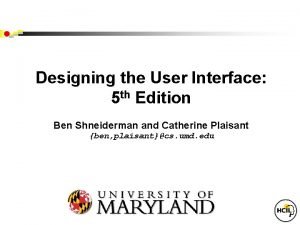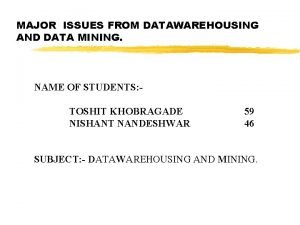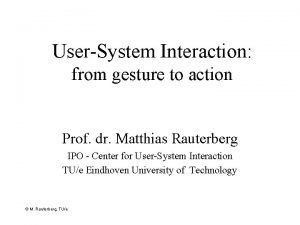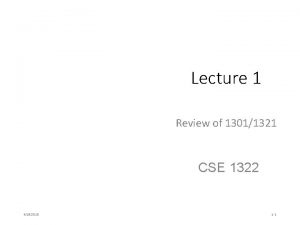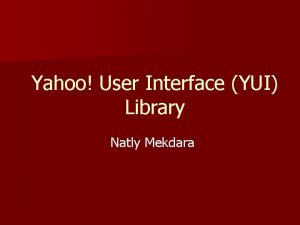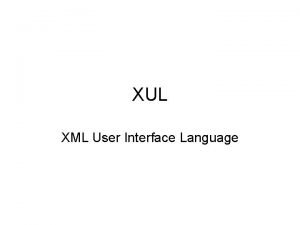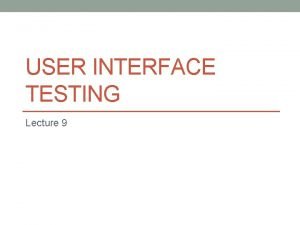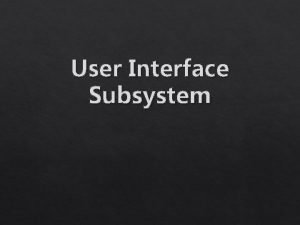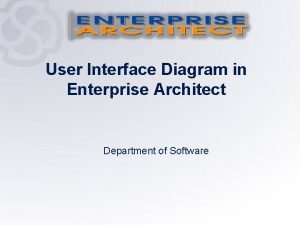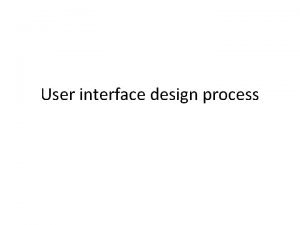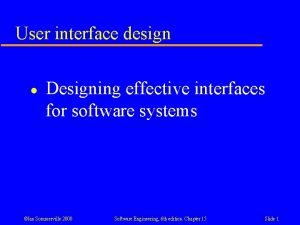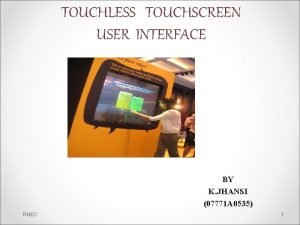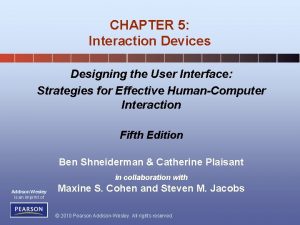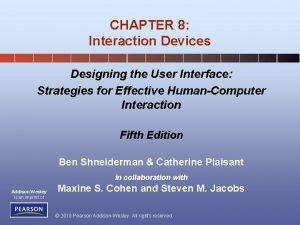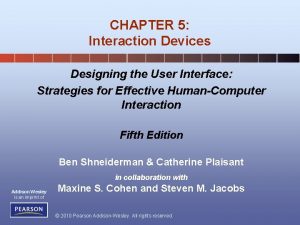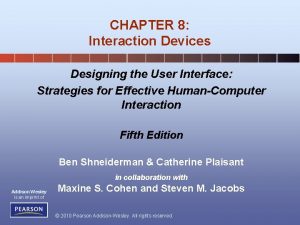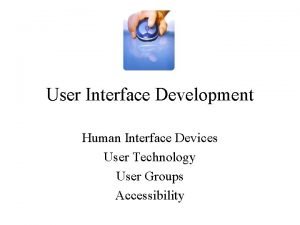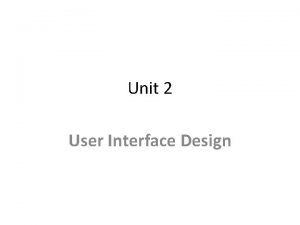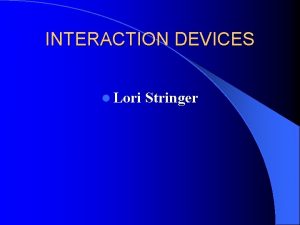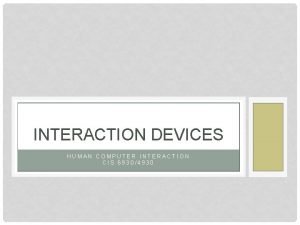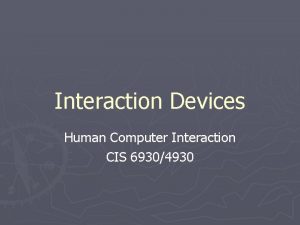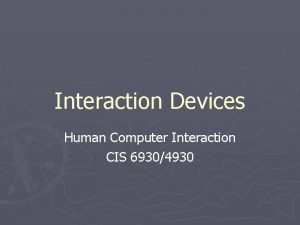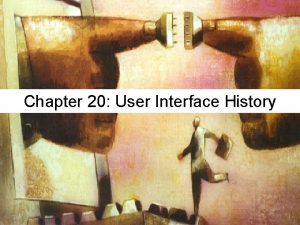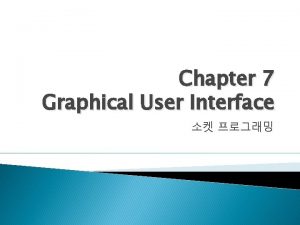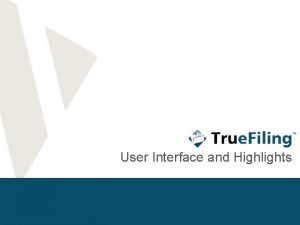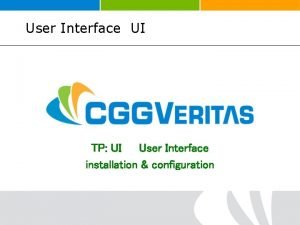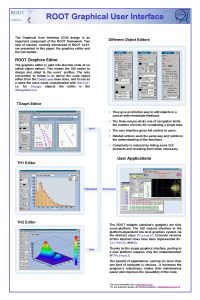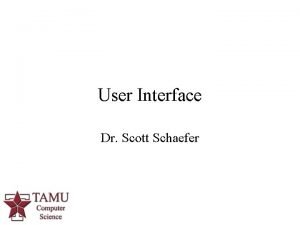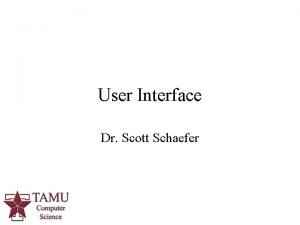CHAPTER 5 Interaction Devices Designing the User Interface





















- Slides: 21

CHAPTER 5: Interaction Devices Designing the User Interface: Strategies for Effective Human-Computer Interaction Fifth Edition Ben Shneiderman & Catherine Plaisant in collaboration with Addison Wesley is an imprint of Maxine S. Cohen and Steven M. Jacobs © 2010 Pearson Addison-Wesley. All rights reserved.

Interaction Devices • Keyboard Layouts • Pointing devices • Novel devices • Speech & auditory interfaces • Displays 1 -2 © 2010 Pearson Addison-Wesley. All rights reserved. 8 -2

Speech and auditory interfaces • Speech recognition still does not match the fantasy of science fiction: – demands of user's working memory – background noise problematic – variations in user speech performance impacts effectiveness – most useful in specific applications, such as to benefit handicapped users 1 -3 © 2010 Pearson Addison-Wesley. All rights reserved. 8 -3

Speech and auditory interfaces (cont. ) 1 -4 © 2010 Pearson Addison-Wesley. All rights reserved. 8 -4

Discrete word recognition o Recognize individual words spoken by a specific person; can work with 90 - to 98 -percent reliability for 20 to 200 word vocabularies o Speaker-dependent training, in which the user repeats the full vocabulary once or twice o Speaker-independent systems are beginning to be reliable enough for certain commercial applications 1 -5 © 2010 Pearson Addison-Wesley. All rights reserved. 8 -5

Continuous-speech recognition § Challenges: o Difficulty in recognizing boundaries between spoken words o Normal speech patterns blur boundaries o Diverse accents o Variable speaking rates o Disruptive background noise o Challenging emotional intonation 1 -6 © 2010 Pearson Addison-Wesley. All rights reserved. 8 -6

Continuous-speech recognition Applications of CSR systems: § Enable users to dictate letters and compose reports verbally for automatic transcription. § Enable automatic scanning and retrieval from radio or television programs, court proceedings, lectures, or telephone calls for specific words or topics. Examples: § IBM Via. Voice® speech-dictation system o Dragon® - Naturally. Speaking™ Medical system 1 -7 © 2010 Pearson Addison-Wesley. All rights reserved. 8 -7

Voice Information System § Interactive Voice Response (IVR) – can provide good customer service at low cost. § Voice Information technologies are used in Personal Voicemail systems. § Telephone based speech systems enable storing and forwarding of spoken messages with user commands entered with keyboards. ( eg: Whatsapp) § Small hand held voice note-takers available in the market. § Audio books have been successful – allow users to control the pace, while conveying the curator’s enthusiasm or author’s emotions. 1 -8 © 2010 Pearson Addison-Wesley. All rights reserved. 8 -8

Speech generation § Speech generation is a successful technology: • Inexpensive, compact and reliable systems using digitized speech segments have been used in Automobile Navigation System, Internet services, Utility Control rooms and Children's games. § Applications for Blind: • Text-to-speech utilities like the built-in Microsoft Windows Narrator. • Screen readers like Freedom Scientific’s JAWS – allows users with visual impairments to productively navigate between windows, select applications, browse graphical interfaces and read text © 2010 Pearson Addison-Wesley. All rights reserved. 1 -9 8 -9

Displays – Small and Large • The display has become the primary source of feedback to the user from the computer • The display has many important characteristics, including: • • Physical dimensions (usually the diagonal dimension and depth) Resolution (the number of pixels available) Number of available colors, color correctness Luminance, contrast, and glare Power consumption Refresh rates (sufficient to allow animation and video) Cost Reliability 1 -10 © 2010 Pearson Addison-Wesley. All rights reserved. 8 -10

Displays – Small and Large (cont. ) Usage characteristics distinguish displays: • Portability • Privacy • Saliency • Ubiquity • Simultaneity 1 -11 © 2010 Pearson Addison-Wesley. All rights reserved. 8 -11

Display technology • Raster-scan cathode-ray tube (CRT) – electron beam sweeping out lines of dots to form letters – refresh rates 30 to 70 per second • Liquid-crystal displays (LCDs) – voltage changes influence the polarization of tiny capsules of liquid crystals – Thin film, light weight, low electricity consumption • Plasma Displays – rows of horizontal wires are slightly separated from vertical wires by small glass-enclosed capsules of neon-based gases – Flat profile, consume more electricity 1 -12 © 2010 Pearson Addison-Wesley. All rights reserved. 8 -12

Display technology (cont. ) • • Light-emitting diodes (LEDs) o certain diodes emit light when a voltage is applied o arrays of these small diodes can be assembled to display characters o Used in large public displays, curved displays o Matrices of some miniature LEDs are also used in some headmounted displays. Organic Light-emitting diodes (OLEDs) o Durable & energy efficient o Laid on flexible plastic or metallic foil o Used with wearable or rollable displays 1 -13 © 2010 Pearson Addison-Wesley. All rights reserved. 8 -13

Display technology (cont. ) • • Electronic ink technology – Paper-like resolution – Tiny capsules with negatively charged black particles and positively charged white particles can be selectively made visible. Tiny Projectors – Microvision Pico projectors – • Project color images on the wall from mobile devices Braille displays – for the blind users 1 -14 © 2010 Pearson Addison-Wesley. All rights reserved. 8 -14

Large Displays § Informational wall displays § Interactive wall displays § Multiple desktop displays 1 -15 © 2010 Pearson Addison-Wesley. All rights reserved. 8 -15

Large Displays 1 -16 © 2010 Pearson Addison-Wesley. All rights reserved. 8 -16

Large Informational Wall Displays • Effective in Control rooms • Details can be retrieved on individual consoles • Applications: o Military command control operations o Utility Management o Emergency response o Allows teams of collaborating scientists and decision makers 1 -17 © 2010 Pearson Addison-Wesley. All rights reserved. 8 -17

Interactive Wall Displays • Large touch sensitive screen on which a computer screen is projected • Digital white board System: o SMART Board® from SMART technologies Inc. o Colored pens and digital eraser simulate a traditional white board o Facilitates Screen recording and software keyboard 1 -18 © 2010 Pearson Addison-Wesley. All rights reserved. 8 -18

Multiple Desktop Displays • Discontinuities in the overall display space • Can be of different size and resolution • Users to stand or rotate their heads or bodies to attend all displays • Useful for personal creative applications • Example: Flash application might require a timeline, a stage, graphic component editors, a scripting language editor, a directory browser and a preview window, all open at the same time. 1 -19 © 2010 Pearson Addison-Wesley. All rights reserved. 8 -19

Heads-up and helmet mounted displays § A heads-up display can, for instance, project information on a partially silvered widescreen of an airplane or car. § A helmet/head mounted display (HMD) moves the image with the user. § 3 D images 1 -20 © 2010 Pearson Addison-Wesley. All rights reserved. 8 -20

Mobile device displays • Currently mobile devices used for brief tasks, except for game playing • Optimize for repetitive tasks • Custom designs to take advantage of every pixel • Data. Lens allows compact overviews • Web browsing difficult • Okay for linear reading, but making comparisons can be difficult 1 -21 © 2010 Pearson Addison-Wesley. All rights reserved. 8 -21
 Ben shneiderman designing the user interface
Ben shneiderman designing the user interface Abowd and beale framework example
Abowd and beale framework example Mining methodology and user interaction issues
Mining methodology and user interaction issues User system interaction
User system interaction Cse 1322
Cse 1322 What is interface in java
What is interface in java Industrial interfaces
Industrial interfaces Interface------------ an interface *
Interface------------ an interface * Yahoo user interface
Yahoo user interface What is xul
What is xul Graphical user interface testing
Graphical user interface testing User interface management system
User interface management system Scratch interface labeled
Scratch interface labeled Principle of input design
Principle of input design User interface design cycle
User interface design cycle Importance of user interface
Importance of user interface User interface in software engineering
User interface in software engineering User interface analysis and design
User interface analysis and design Touchless touchscreen
Touchless touchscreen Web user interface
Web user interface Principles of user interface design
Principles of user interface design Interactible
Interactible
